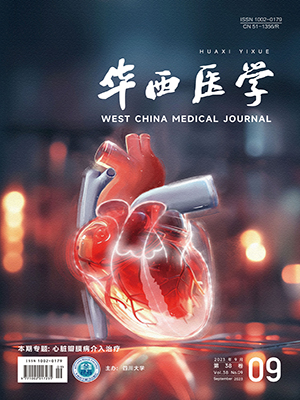【摘要】 目的 探討影響糖皮質激素治療特發性血小板減少性紫癜療效的主要因素。 方法 回顧分析2008年1月-2010年7月173例特發性血小板減少性紫癜患者的臨床資料,采用χ2檢驗及Logistic回歸分析影響糖皮質激素療效的相關臨床因素。 結果 單因素χ2檢驗分析顯示性別、骨髓巨核細胞計數水平、骨髓產板巨核細胞比例、乙型肝炎表面抗原(HBsAg)、血清免疫球蛋白水平對糖皮質激素療效的影響有統計學意義(P lt;0.05)。脾臟長大、抗核抗體(ANA)陽性、補體C3水平降低與糖皮質激素療效無關。多因素Logistic回歸分析顯示性別、HBsAg是影響糖皮質激素療效的相關因素。 結論 男性、骨髓巨核細胞計數增多、產板巨比例降低者對糖皮質激素治療反應較好。女性、血清免疫球蛋白水平異常、骨髓巨核細胞不增多者及HBsAg陽性的患者對糖皮質激素治療反應相對較差。性別、HBsAg是影響糖皮質激素療效的主要因素。
【Abstract】 Objective To discuss the influencing factors associated with the efficacy of glucocorticoid for idiopathic thrombocytopenic purpura. Methods We retrospectively analyzed the clinical data of 173 patients with idiopathic thrombocytopenic purpura who accepted their first treatment in West China Hospital between January 2008 and July 2010. The affecting factors on the efficacy of the treatment were analyzed by means of Chi-square test and binary logistic regression analysis. Results The results of Chi-square test showed that gender, bone marrow megakaryocyte count, the percentage of platelet-producing megakaryocytes, HBsAg, and the level of serum immunoglobulin could have a significant influence on the outcome of glucocorticoid treatment (P lt;0.05), while splenomegaly, positive ANA and decreasing of the level of complement C3 were not correlated with the outcome of glucocorticoid treatment. The results of multivariate logistic regression analysis showed that gender and HBsAg were correlated with the glucocorticoid treatment for patients with idiopathic thrombocytopenic purpura. Conclusion Male patients, patients with increasing bone marrow megakaryocytes and patients with decreasing percentage of platelet-producing megakaryocytes have better responses to glucocorticoid, while female patients, patients with abnormal serum immunoglobulin level and patients with non-increasing number of bone marrow megakaryocytes have poor responses toward glucocorticoid treatment. Gender and HBsAg are the main influencing factors for the response to glucocorticoid.
引用本文: 余敏,廖小梅,徐才剛,牛挺. 糖皮質激素治療特發性血小板減少性紫癜療效相關因素分析. 華西醫學, 2011, 26(3): 331-334. doi: 復制




